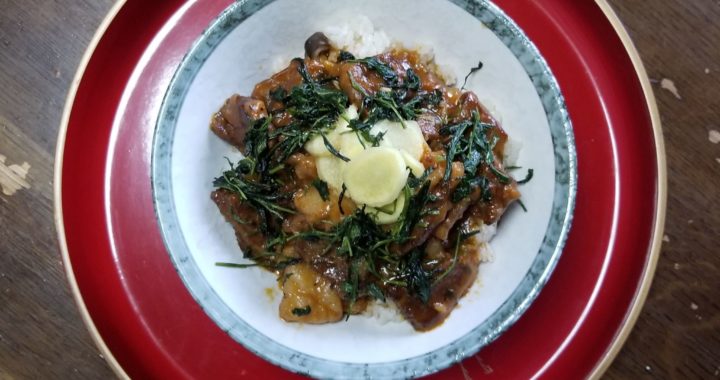Kai’s Kitchen
An entree Steeped in History
What’s good y’all? Welcome back to the 5th installment of Kai’s Kitchen! Well ladies, gentlemen, and everyone in between – we have arrived at the main course. We’ve had an appetizer, soup, fish, salad, and now we have our entree! For something as important as this, I wanted to do something traditionally Japanese, but still put a little bit of a twist on it. At first, I thought about doing something big and grand like a nabe (hot pot) with tons of different ingredients boiling like mad inside it. Then I thought about some sort of hot or cold ramen dish. But finally, I landed on something even more traditional – a donburi. What is donburi?
Donburi is as simple as it is delicious. Donburi (normally abbreviated as don) literally translates to the word “bowl” and is a bowl filled with rice, then topped with vegetables and meat, or fish, all simmered together. Donburi can be basically anything you want it to be. Want to top it with tempura? That’s a tendon. Want a beef bowl? That’s a gyudon. Feeling like eel? Unagi don. Egg? Tamagodon. If there is hot, simmered, and delicious food on top of a big bowl of fluffy rice, you got yourself a donburi. So, what are we making this week? I’m very, very excited to introduce the main course of Kai’s Kitchen, a donburi that features gyokuro rice with braised beef, shiitake mushrooms, thinly sliced pickled ginger and fried gyokuro. For this dish, the tea we are using is one of the most phenomenal teas I’ve had while I’ve been at Obubu, Gyokuro!
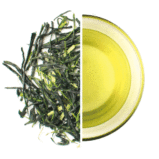
Gyokuro is a Japanese sencha that undergoes a long shading process – cutting off the sunlight from the growing leaves – making Gyokuro sweet, umami, and delicate. Gyokuro is shaded for roughly 3 weeks, which contributes to that flavor profile. Much like the Kabuse we used in week one for the Kabuse bruschetta, the shading process makes the tea sweet, because of the increased amount of theanine in the plant that comes from shading. The difference between Gyokuro and Kabuse and other teas is the amount of time the tea stays in the shade, making it much sweeter. The history of Gyokuro is rather simple. Yamamoto Kahei (the 6th) was a well-known tea merchant who traveled to Uji to study tea production in that area. The farmers there shaded their teas to protect them from the frost of winter, and that year the winter was longer and harsher than usual. By the time the frost had finally let up, the tea had been shaded for longer than it normally would be, and when tasted, was instantly love by Yamamoto. He brought back the cultivation technique and continued the tradition, and the rest is history.
That’s enough facts, let’s get cooking!
Gyokuro rice with Braised Beef, Shiitake Mushrooms, Pickled Ginger and Fried Gyokuro
Ingredients
2 cups of rice
4 cups of Gyokuro, brewed (leaves saved)
2 pieces of ginger
1 ½ cup of vinegar
¾ cup sugar
4-5 shiitake mushrooms
2 pounds of beef chuck
2 tbsp all-purpose flour
1 tsp salt
⅓ tsp black pepper
2 onion
6 cloves of garlic
5 green onions
4 tbsp miso
¼ cup soy sauce
1 cup chicken stock
½ cup of tomato paste
¼ cup oyster sauce
½ cup sake
4 tbsp of olive oil
2 tbsp honey
1 tbsp brown sugar
2 tbsp butter
Recipe
We are going to start the night before with the pickled ginger. Skin the ginger and dice into small ½ inch by 2-inch strips and place into a mason jar. Pour the vinegar into a small sauce pot and turn onto a medium low heat. When it hits a simmer, add sugar and mix until completely dissolved. Once dissolved and the smell has dispersed, wait till cool, then add to the mason jar full of ginger. Screw tightly and set in fridge overnight.
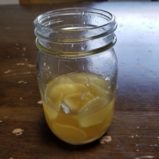
The next day, start by sifting the all-purpose flour, salt, and pepper into a medium sized bowl and set aside. Take your 2 pounds of beef chuck and cut into small, easy to eat bite sized pieces and toss in the flour dredge. Pour the oil into a large pot (cast iron pot preferred) and set over medium heat, take care that the flour doesn’t burn. Take the beef and shake off any large chunks of flour, and place into the pot. We aren’t looking to fully cook it; we just want to give it a nice color and crust. Once done remove from the pot and place on a plate.
Take the chicken stock and deglaze the pot. Add minced garlic, green onion, and white onion and cook till aromatic. While this cooks, in a large bowl whisk the miso, soy sauce, tomato paste, hoisin, sake, honey, and brown sugar. Add this mixture to the pot. Add the meat. Add water till the meat is almost covered. Set on low and let simmer. This will take about 3 hours. Check every 30 minutes, stirring and setting the doneness of the meat.
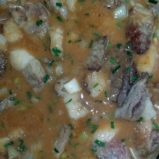
Now we are going to start with the rice. First things first – brew about 4 cups of Gyokuro and keep the leaves. Set the leaves on a sheet pan lined with paper towel and set in the fridge; we will need them for later. If you brew the Gyokuro at a lower temperature, you can brew using the same tea leaves all 4 times. Once brewed set aside. Wash and dice the shiitake. Then take your rice and thoroughly rinse it 2-3 times and once rinsed, add it, the gyokuro, and shiitake to your rice cooker and let cook.
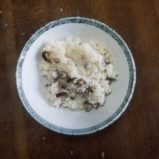
Take a small pan and melt the butter, once fully melted, add the Gyokuro leaves. Cook till crispy and then salt and pepper to taste.
Once everything is done, scoop out the rice and place into your favorite large bowl, and add a large scoop of the braised beef. Top with pickled ginger and fried Gyokuro and BAM. Serve it up!
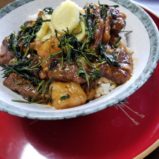
Well folks, that was the main course. I’ve got to say, this was the most challenging recipe I’ve created to date, but very satisfying and the most delicious so far. Donburi is essential to Japanese cuisine, and something enjoyed by many people all over this island. The braised beef comes out so tender it falls apart and when paired with the pickled ginger and shiitake mushroom gyokuro rice, it makes for an amazing centerpiece to any meal. Even if you aren’t Japanese or didn’t grow up eating Japanese food, this meal is reminiscent of good old school home cooking. Hearty, sweet, zingy, and stick-to-your-bones, it is a perfect meal for impressing friends or family with how thick, rich, and satisfying this dish is. This one may take a bit of time, but I speak for everyone here when I say how worth the effort it is.
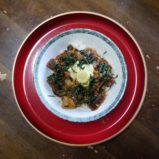
We only have one more week of Kai’s Kitchen and I have to say, it’s been an amazing journey. Stay tuned in for the last week, when we will be closing things down with a tea infused dessert! Let me know if you try this recipe at home and how it turned out! Until next time, keep drinking spectacular teas and keeping cooking and eating delicious food!
Kai Masuchika, Chef, Obubu Intern

